Use your Zettelkasten as a research, thinking and learning tool – Personal knowledge management as a system
The Zettelkasten as presented in the previous part of the series about personal knowledge management provides a practical implementation of our targeted knowledge network. We saw that the Zettelkasten is more than a mere method for creating a smart knowledge database. The entire workflow can be seen as a systemic process that covers several steps of typical scientific work, from collecting new knowledge, its processing, the networking of knowledge and finally creating new scientific outputs. In the last part of the series we therefore take a look at how we can integrate the Zettelkasten into our research workflow as an overall system of personal knowledge management.
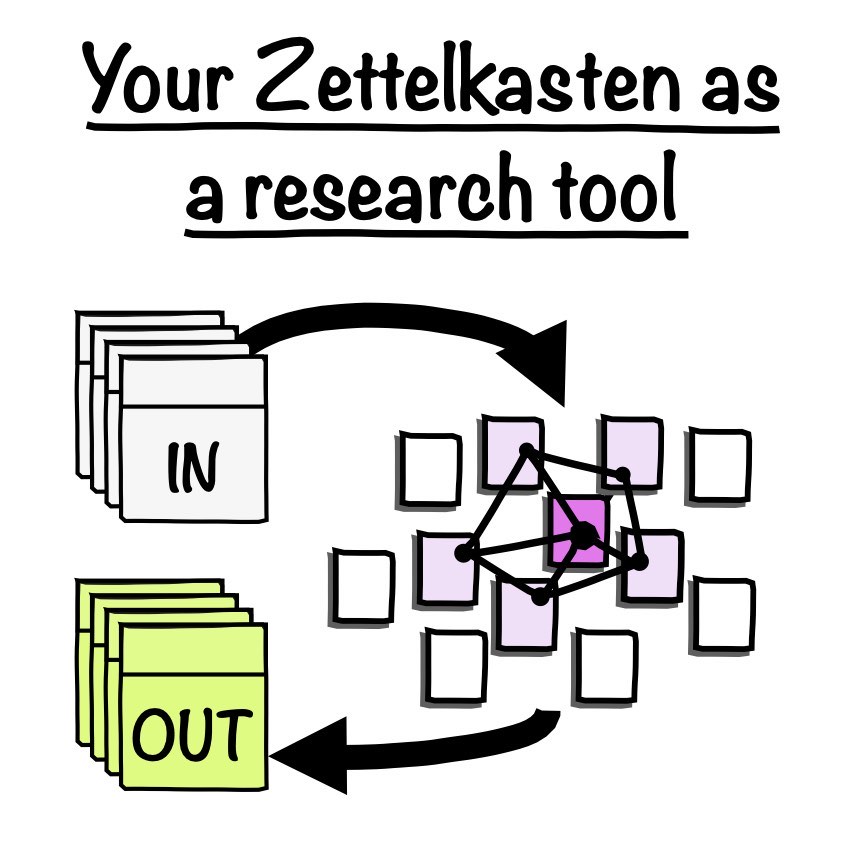
We first discuss the basic work with the Zettelkasten on a macroscopic level, then we go deeper into the internal processes within the Zettelkasten.
Working with the Zettelkasten on a macroscopic level
As mentioned in the previous part, we should not just fill the Zettelkasten with notes – we also have to work and interact with it. The Zettelkasten is not meant to serve as an archive for our gathered knowledge. Remember that we are looking for a dynamic and vivid knowledge network, that relieves us of parts of our work – at least the rather technical ones – so that we have more time for the creative work. We want this network to become the “source-machine” for our scientific output. Therefore, it should reveal connections that we wouldn’t see from isolated information solely. It should not only show these connections, but also reinforce them and show us relationships within their context. Knowledge about how, who and why connections are created also triggers further knowledge. Drawing conclusions from the informational bits in our externally stored knowledge and from their connections and relations with each other is the creative part in the process of creating new content, which we have to carry out ourselves. However, we want the Zettelkasten to decrease parts of the “technical” work in preparing this new content.
In order for the Zettelkasten to work, we have to establish a relationship to it. Working with the Zettelkasten does not only include inserting and retrieving information. We also have to continuously work with it, which covers some general and repeating steps:
- Collecting and Connecting
- Collecting and inserting information into the network and creating connections between the notes are basic steps and let our knowledge network establish, keep it up-to-date and operational. This also includes the completion of existing notes and the filling of knowledge gaps.
- Constant Reviewing
- Reviewing our notes is a constant process, from which also our learning skills can benefit. It is not just about discovering errors and making additions to our notes. Reviewing our notes immediately after their creation or after some time forces us to keep dealing with its content again and again. We might discover completely new, previously overlooked connections between topics. The constant review not only strengthens our knowledge network, but also deepens our understanding on certain topics.
- Research your network
- By taking one note as a starting point and following its associated links we research our network and draw the broader picture on a certain topic. In this way, we discover connections that have not yet been seen and that are more difficult to recognize with notes, that would have remained isolated.
- Creating new content
- We create new content based on the information within our network, the detected connections and our conclusions about them.
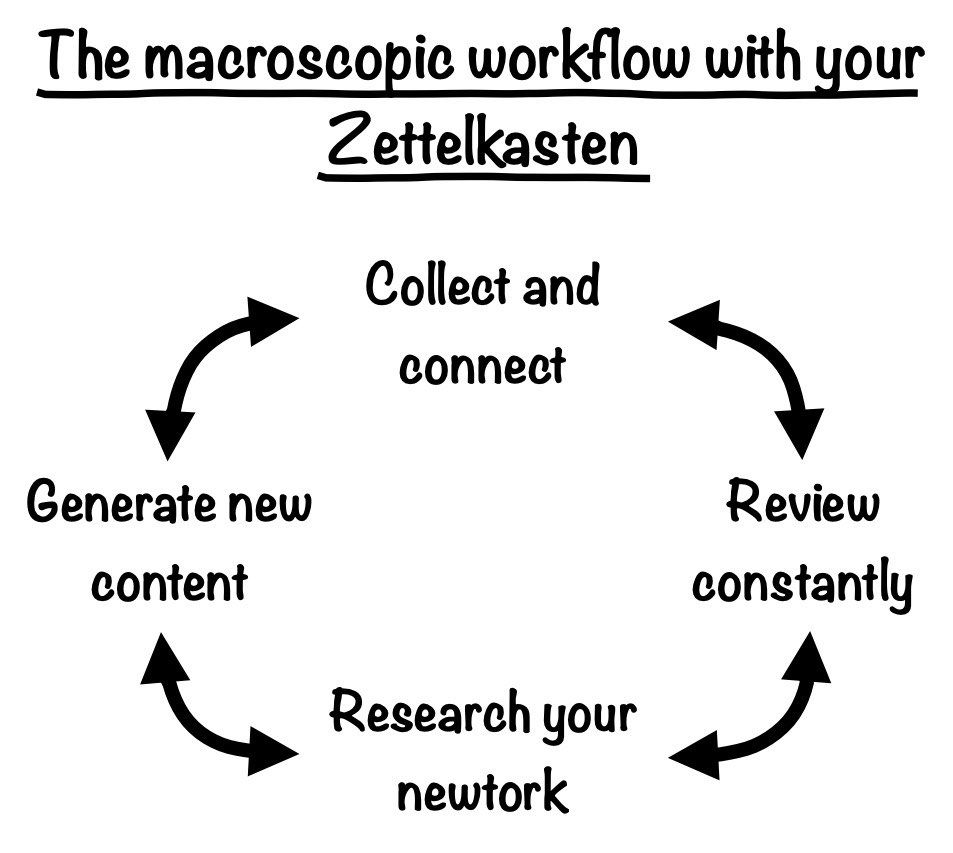 Workflow with our Zettelkasten on a macroscopic level.
Workflow with our Zettelkasten on a macroscopic level.
How to research the knowledge network to create new output
There are three different entry points to research our network:
- Accessing the knowledge network layer directly
- Having one note on a specific topic in mind, we start to follow its tracks and discover expected as well as unexpected connections and relations.
- Free-form text search
- As a rather crude research method, free-form text searches can help to find a very specific note or subject, whose exact name we may temporarily have forgotten.
- Topical search via keywords
- Topical search via keywords is another way to discover so far unseen connections between our notes. It differs from directly accessing the knowledge network in the way, that the connections on the topical level do not consist of concrete links attached within the note, but they lie on a more superficial layer. While writing a permanent note, we link it to relevant other ones. And “relevant” here means linking in the context of the research that we did, when we wrote the note. Applying keywords (“tagging”), on the other hand, means linking the note to a more general subject, without seeing which other notes are already associated with that subject while you apply the keyword. Researching the keywords then reveals these “invisible” connections.
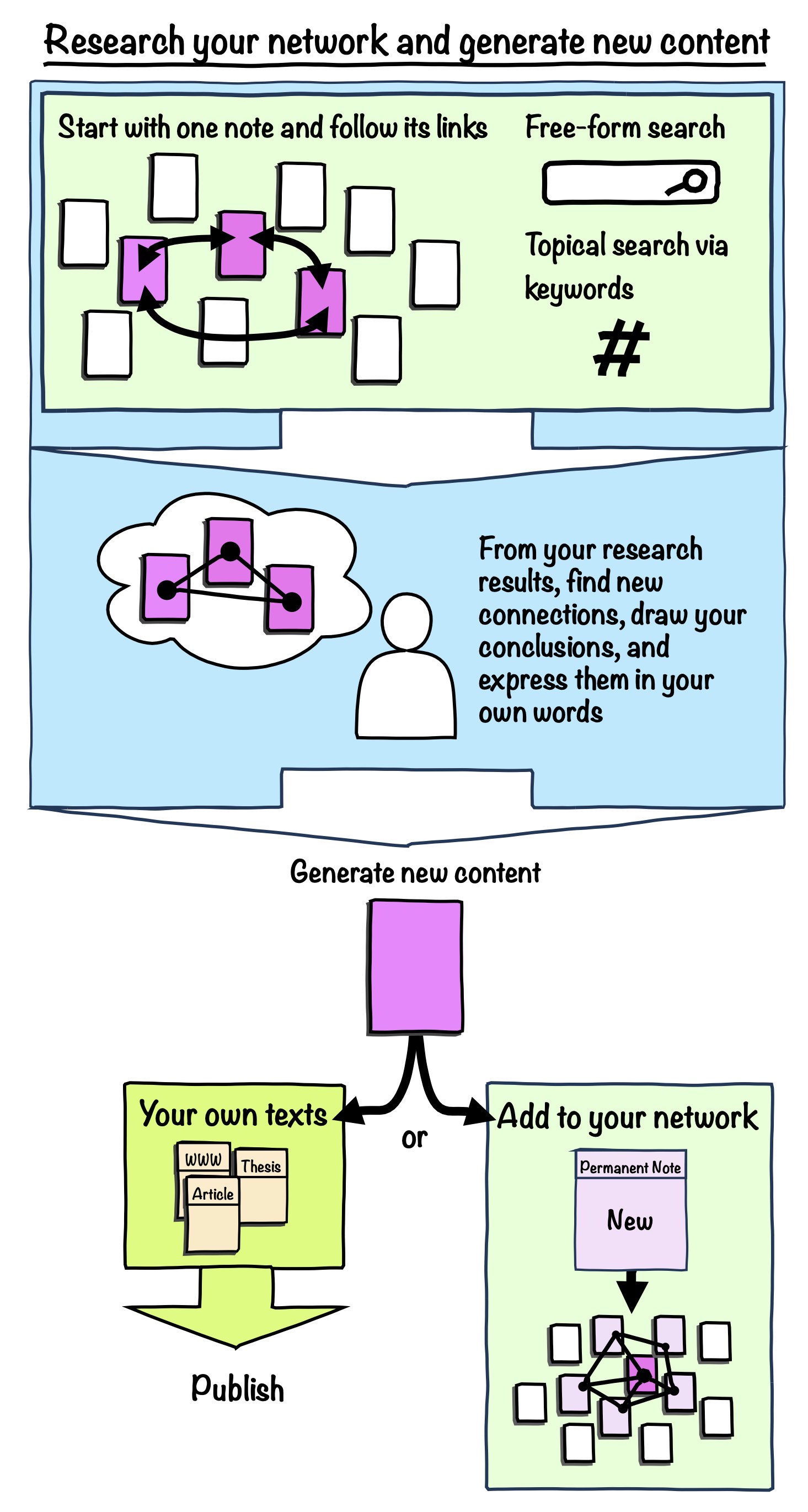 How to research your network to create new content.
How to research your network to create new content.
It is also helpful to keep a temporary track of the discovered linked notes during a network research, e.g., on a fleeting note. This fleeting note can be deleted if it’s not used anymore, or it becomes a literature note, if we decide to keep it as a documentary of our research and a source of potentially resulting new output.
Creating new content by applying the methods listed above is a so-called bottom-up approach in contrast to a top-down approach: Instead of already having a fixed idea about the topic we’d like to write about in mind (top-down), we research our network without subjective biases and let the results of our network research define the topic (bottom-up). I.e., perhaps in the end we have a completely different topic that we discovered in our network research than we originally had in mind. The bottom-up approach is therefore unbiased and keeps our mind open for any possible and often surprising conclusions from our network researches.
Communication within and with the Zettelkasten – Personal Knowledge Management as a system
In the second part of this series we als already discovered that our Zettelkasten contains at least two different layers, the input layer and the knowledge network layer. In addition to these two, there exists a third one, that is actually crucial for the entire Zettelkasten workflow. We already discussed its functionality, but so far we haven’t clearly defined it: the communication layer.
The transfer of the inputs from a medium to a literature note, from the literature note to a permanent note, and from the permanent notes to a new scientific output is not a given and self-sustained process. It is actually us who take care of these transfer steps as a creative process. The layer, in which this creative process as an integral part of the Zettelkasten happens, is what I’d like to call the communication layer.
Why communication? Because this is the layer, in which the communication between inflowing information and the knowledge network as well as the communication between the knowledge network and the outflowing output takes place. That is why I see this layer as a central and essential link in our Zettelkasten, where not only the other two layers communicate with each other and with the outside world, also we communicate with our Zettelkasten within this layer via research inquiries.
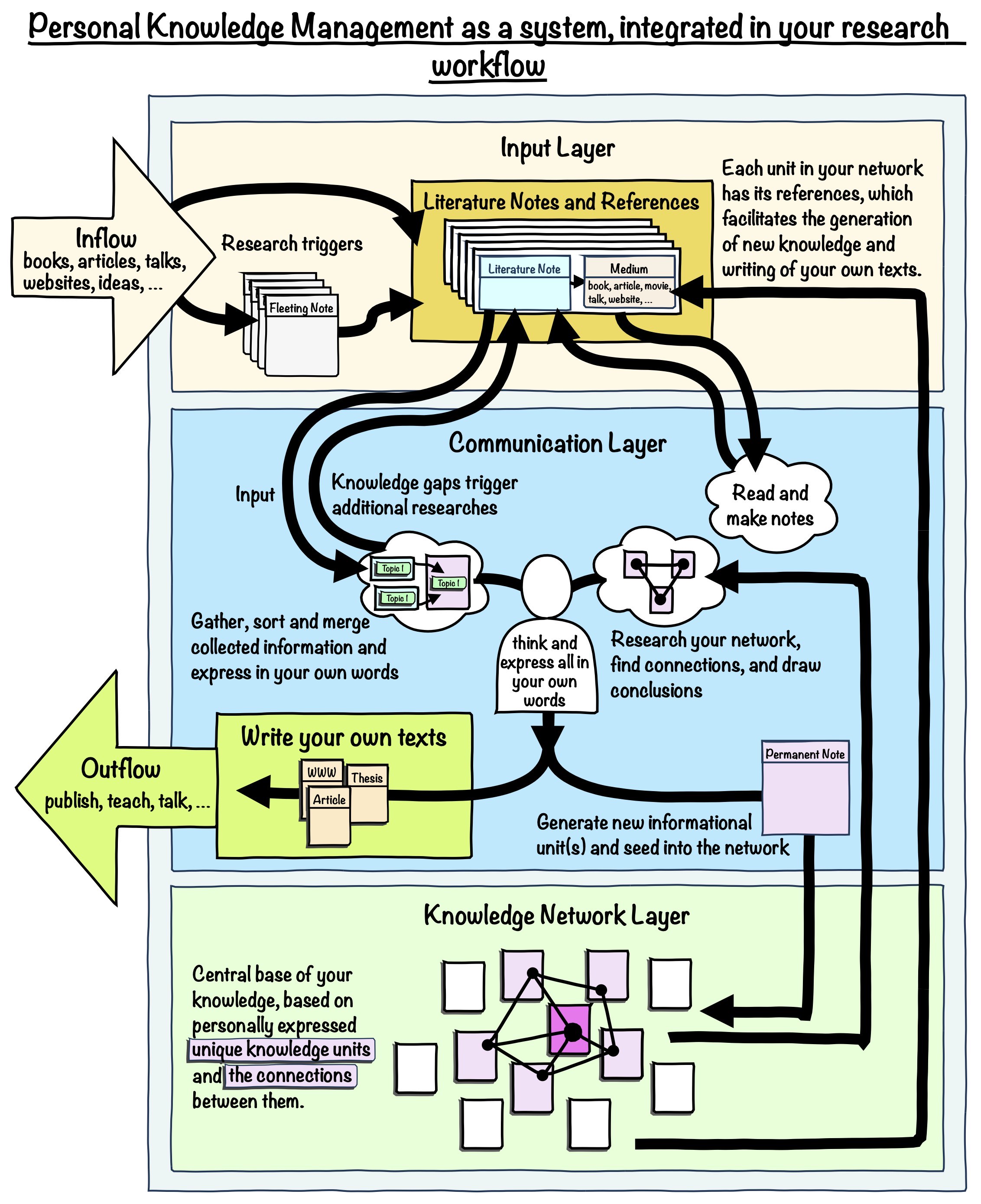 Personal knowledge management as a system: Integrate your Zettelkasten in your research workflow as a dynamical system.
Personal knowledge management as a system: Integrate your Zettelkasten in your research workflow as a dynamical system.
As illustrated in the sketch above, the entire communication of all parts of our Zettelkasten runs within the communication layer. The main task here is to express the information from all inputs (both external and from the knowledge network itself) into our own words and to write them down into a new document (permanent note, literature note, a publication, etc.). This includes:
- reading and processing inputs and transferring our thoughts into a literature note
- transferring collected topics from the literature notes to permanent notes
- finding connections between notes and cross-referencing them within their context
- drawing conclusions from the connections between notes and creating a new permanent note out of it or writing a draft for a new publication (article, thesis, blog, talk, discussion, etc.)
Indeed, in the communication layer not only the individual parts of our Zettelkasten communicate with each other, it’s also us communicating with the Zettelkasten. And this communication is actually a good thing for two reasons:
- we keep a record of our knowledge, that we can easily retrieve and understand, no matter when we review it (practical and general purpose of the Zettelkasten), and
- the communication approach forces us to think about the topic, fill knowledge gaps, and deepen and strengthen our understanding of the underlying topic.
In this sense, the communication layer lets our Zettelkasten become both a thinking tool and a memorization tool. It integrates the entire Zettelkasten workflow as a holistic system into our overall research workflow, covering the reception and processing of inflowing informational inputs, their processing and assessment, and the preparation and generation of new content (outflow) in form of scientific publications, thesis documents, blogs, podcasts, talks, etc., or as a new addition to our so far gathered knowledge.
The processes within the communication layer: The work on the microscopic level
In order for the Zettelkasten to work, we defined some basic rules in the previous part of this series . The knowledge network on the knowledge network layer can only emerge and be maintained by consistently linking permanent notes and by following the mentioned rules. In the input layer, literature notes and thus new inputs can only be created by a skillful literature research. In order to guarantee an effective communication between the two layers, there are also some essential rules for the communication layer.
Basically and as mentioned above, the processes in the communication layer cover the creation of both, permanent notes, literature notes, fleeting notes (the “Zettel” within our Zettelkasten) as well as publications in general (any content written for the outside world). To give these processes a certainty shape, so far, I’ve had good experiences by applying steps from the so-called Feynman method, in order to provide an effective and smooth workflow within the communication layer. The Feynman method is a general approach for effective learning, established by the physicist and Nobel Prize winner Richard Feynman. Specifically for the communication layer, this includes the following processing steps:
- We start with an empty document (either we create a new text document on the digital device of our choice, or we simply take a blank sheet of paper and a pen) and imagine that we would have to explain a specific topic to someone, who absolutely knows nothing about it.
- We carefully think about a title for our document, that exactly describes the topic we’d like to write about, and write it down. This is an important step, as we really have to think about what we actually want to write about. To a certain extent, the title already directs the content in the then following text.
- After setting the title (or at least its first version), we start to write the actual text by describing the topic – in our own words and still keeping in mind to explain the topic to someone else. While writing, we may notice gaps in our knowledge. We keep track of these gaps and write them down on a separate note. We look them up afterwards.
- After finishing the first draft, we look up the tracked knowledge gaps. We complete them within the current text or, if appropriate, we create new permanent notes out of it (or complete existing ones) and link them contextually to the current document.
- We review our text and if it still sounds too complicated, we try to further simplify it. The review process can involve multiple iterations. When we are fully satisfied, we add the document to our Zettelkasten as a permanent or literature note, or we publish it, while publishing means any presentation to the outside world, e.g., we can discuss it with someone else, present it, add it to our thesis or an article, or we post it on our blog.
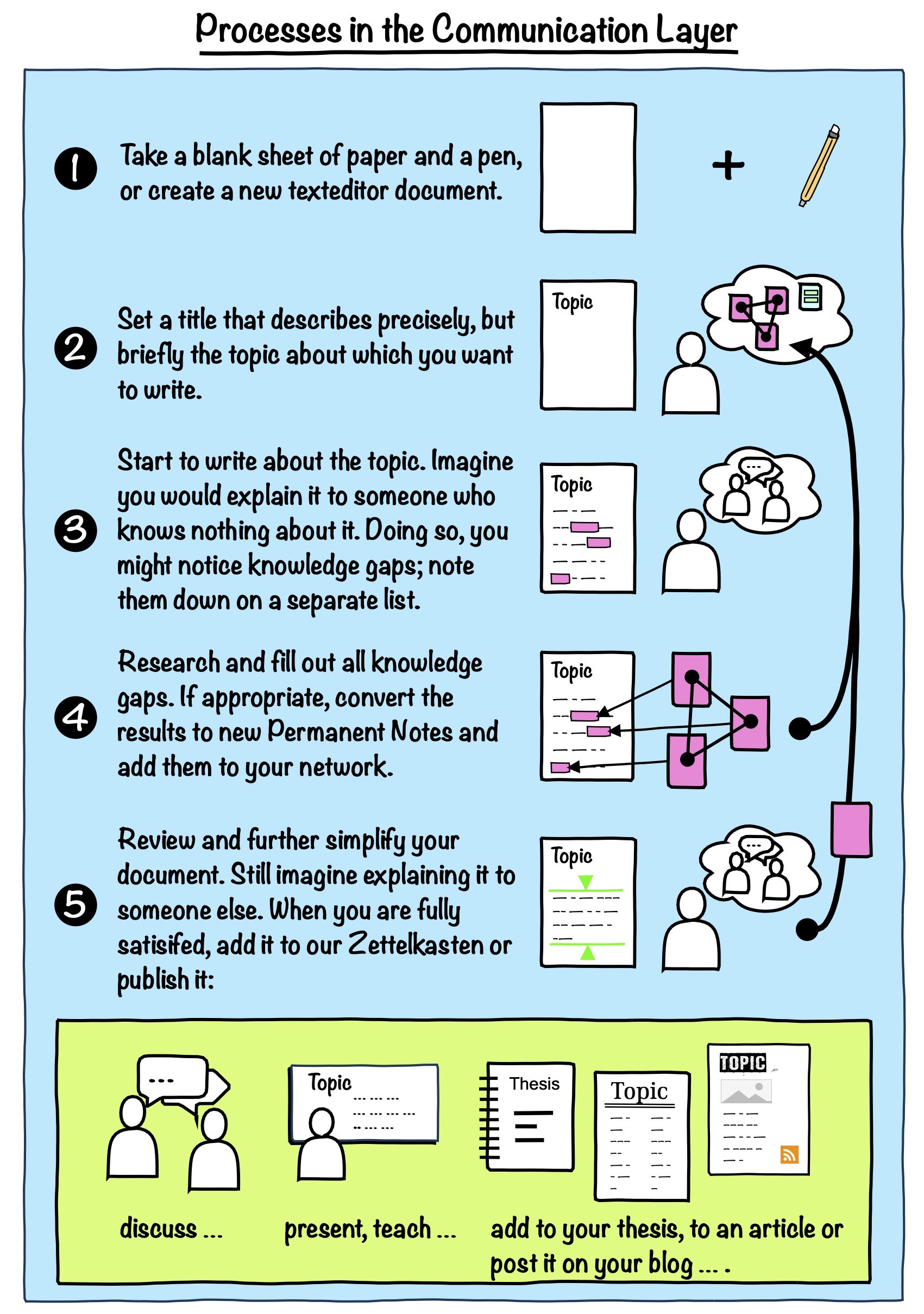 How to process any input (from both, the outside and inside our Zettelkasten) in the communication layer according to the Feynman Method.
How to process any input (from both, the outside and inside our Zettelkasten) in the communication layer according to the Feynman Method.
The biggest effort as well as the most important part in this process is step 3. Here we imagine that we would have to explain the topic to a person, who knows nothing about it. In this imaginary conversation, we may find that we have trouble explaining certain aspects – and that’s actually a good thing! Now we have to think of a way how to convey the complex content to someone else in a simpler way, in our own words while still being correct in terms of the content. Also, we should always try to express our explanations in complete sentences and with the necessary technical terms.
We are not just limited to the written form. We can use everything that can facilitate our explanations – as well as our own understanding. E.g., infographics are a good way to focus and summarize relevant facts of a topic, while being forced to be precise and correct. Creating the graphic, we may also find that we have not fully or correctly understood some aspects of the topic. By creating a comprehensive big picture, where everything has to fit together smoothly, we are able to identify and correct misinterpretations and knowledge gaps.
With this method it hopefully becomes clear, why it is important not to just copy a source (lecture, book chapter, Wikipedia entry) 1:1 into the network. We only have a personal benefit, also in terms of learning, if we summarize and review any inflowing information and express it in our own words. The resulting note reflects our personal and so far understanding of the underlying topic. It is also a representation of knowledge, that is “digested” according to the way we think, which makes the retrieval of information faster and easier. We won’t achieve these benefits if we just save entire Wikipedia or scanned book pages into our Zettelkasten.
How the Zettelkasten becomes our thinking tool
The purpose of the work with our knowledge network is not documenting our process of thinking. Instead, it can become an active part of it. Discussing a topic with someone else, thinking about it focused, or trying to sort it out in writing is an important part in our overall thinking process. The Zettelkasten can help us to sort our thoughts when we research it, summarize and create new content.
The autonomy principle, the immanent requirement of the Zettelkasten to write in such a way, that we can still easily understand a note even years later, forces us to formulate our thoughts correctly. It forces us not to let our ideas stand loose, which always carries the risk to lose the core meaning of the idea and over time we won’t be able to fully understand the corresponding note on it anymore. We also may find, that we actually haven’t fully thought about a topic. As we write about it, more aspects and conclusions come to mind, and our picture of the topic becomes more and more complete and clear. In this way, the Zettelkasten and our work and interaction with it indeed becomes a practical thinking tool.
Final remarks on this series
After this deep dive into personal knowledge management and how to integrate it as a system into a general research workflow, I hope that it contains some fresh and inspiring aspects for you to integrate into your own workflow. In any case, the system is not limited to certain subjects. It can be used in social sciences (which was the subject of Luhmann) and humanities in general, in natural sciences (physics, biology, chemistry, mathematics, informatics, computer sciences, etc.), in vocational training, in our job, in teaching, in learning and further education, or generally for reading books – simply put, in all subjects and use-cases that deal with knowledge work.
If you decide to start your own Zettelkasten, let me provide a last and maybe the most important pieces of advice: Don’t take the “rules” presented in this series too strict! You will definitely create your own Zettelkasten system, that fits best for you and your habits. The Zettelkasten can become a central part of your entire knowledge processing and writing process, so it has to become something that you enjoy. Adapt the Zettelkasten therefore to your needs and not the other way around.
While this series is now complete, I will continue to write about further practical tips on personal knowledge management and the Zettelkasten method.
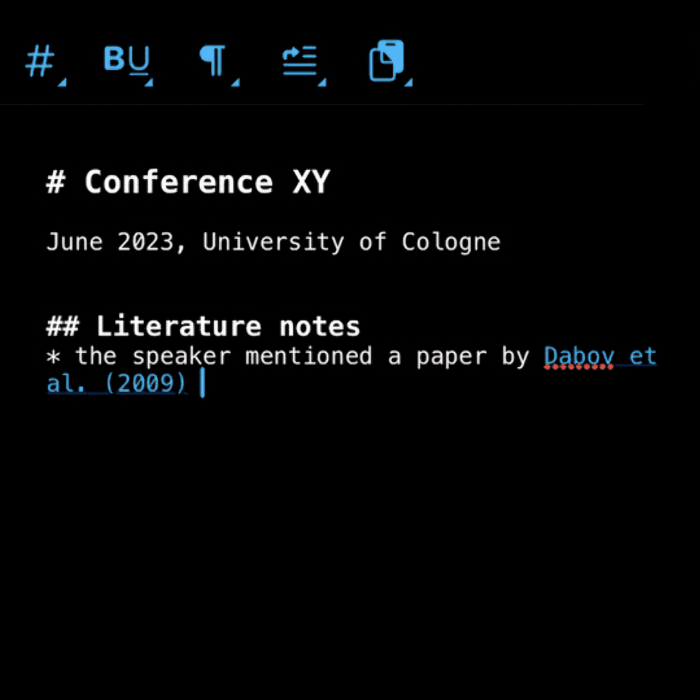
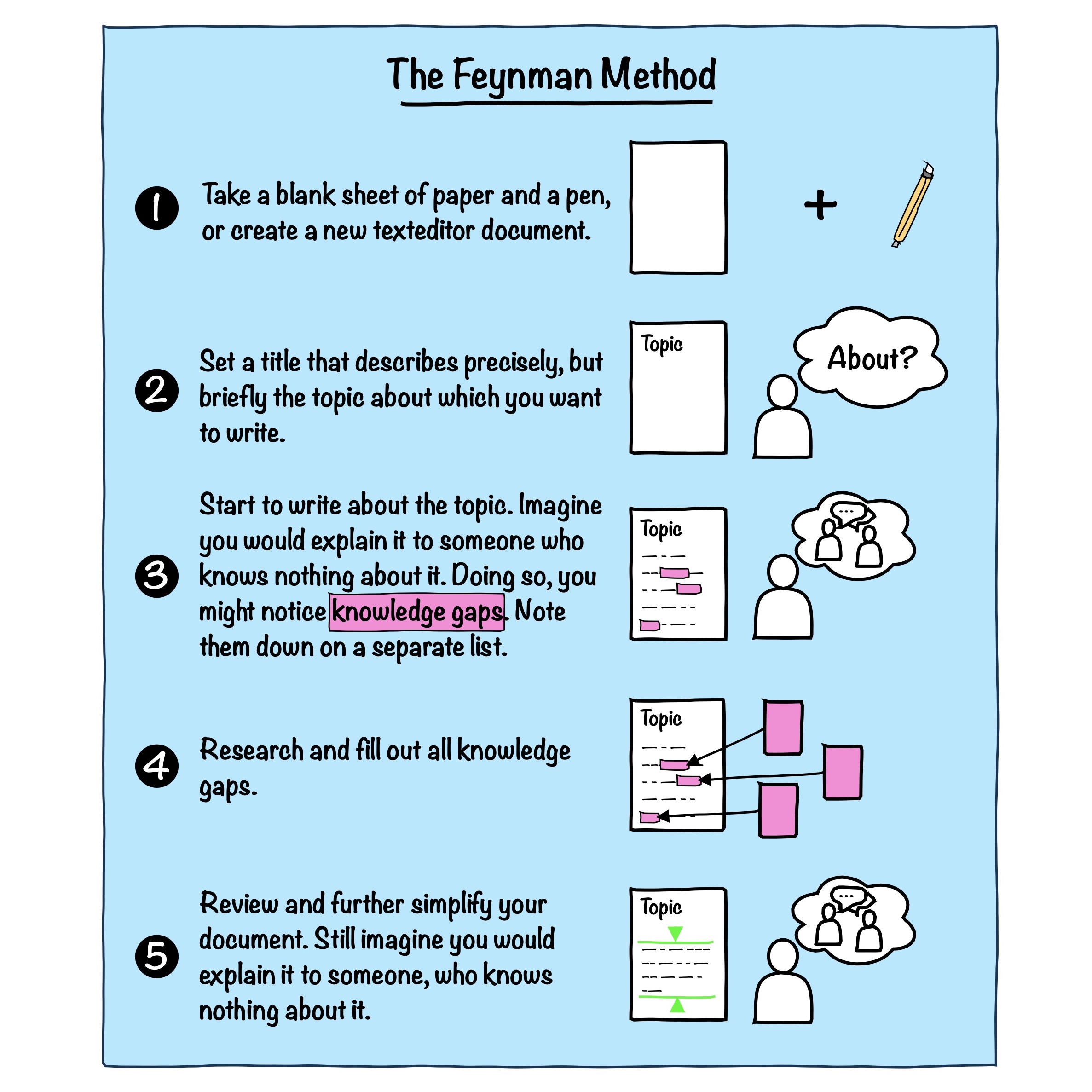
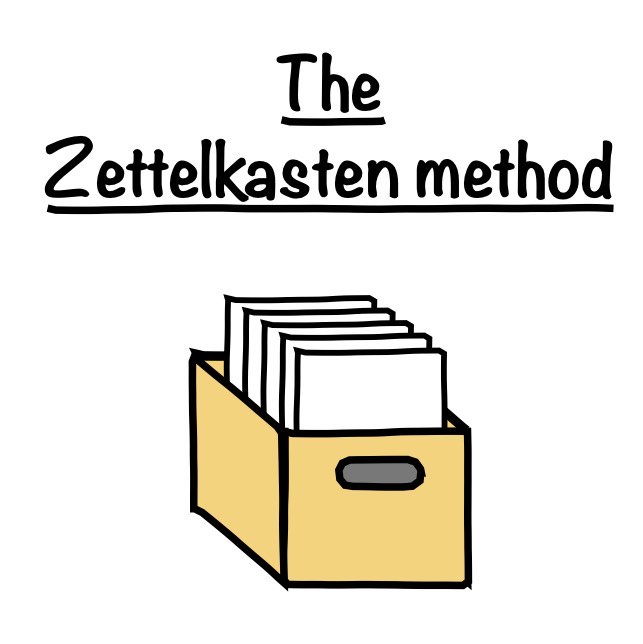
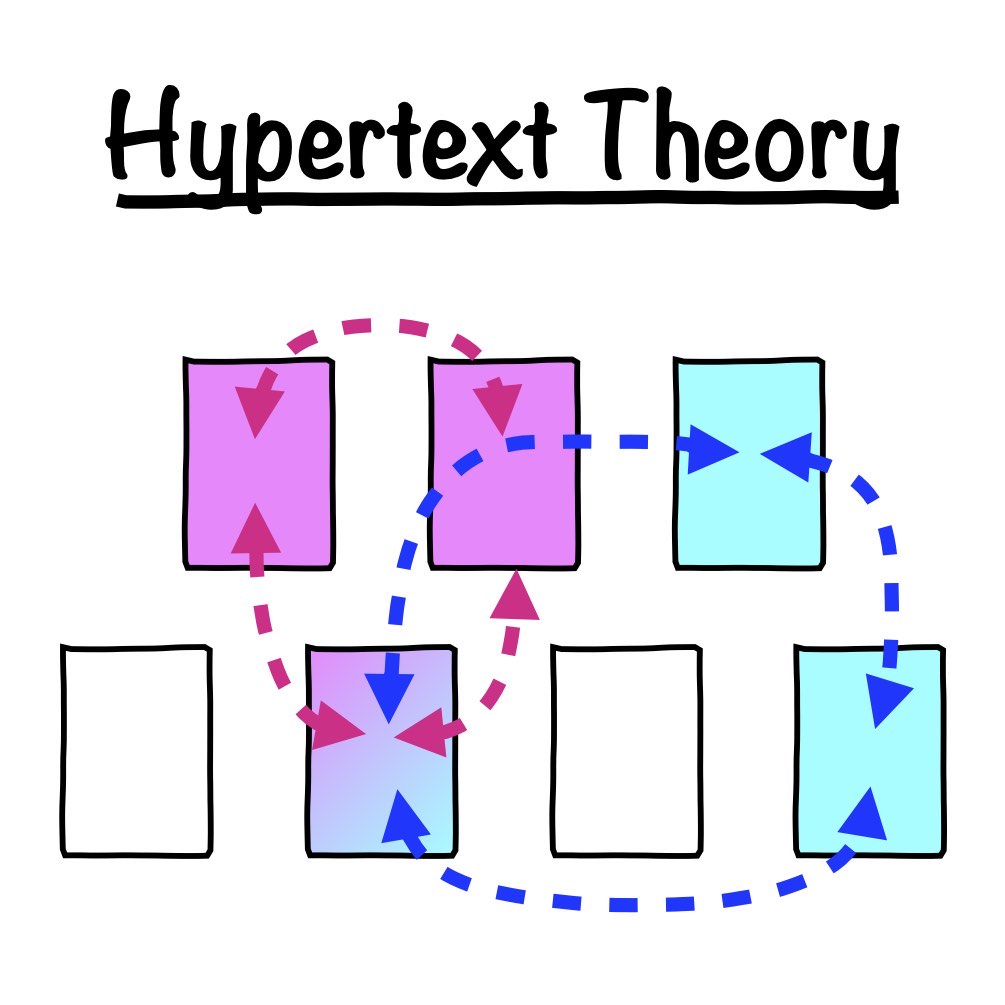
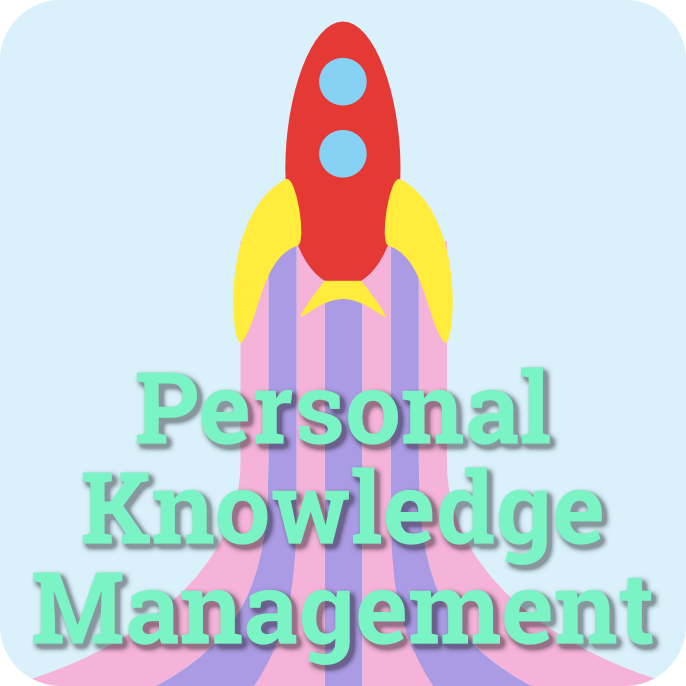
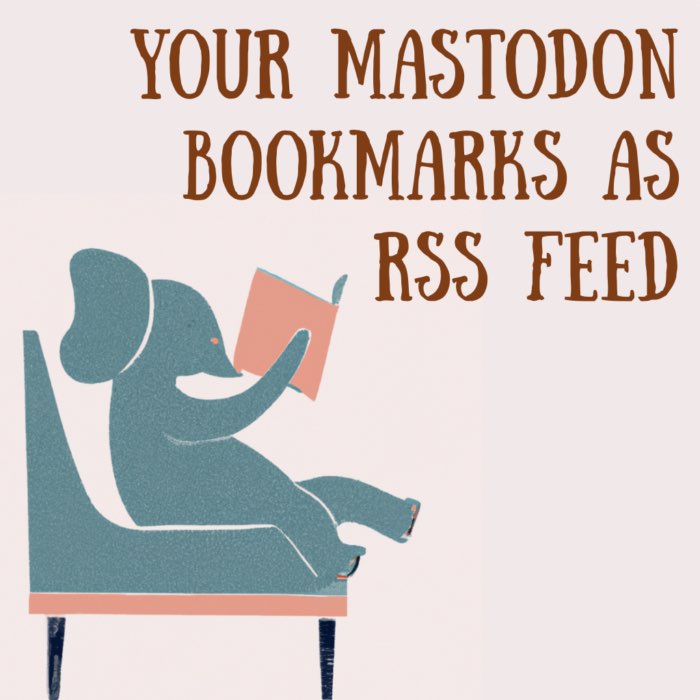
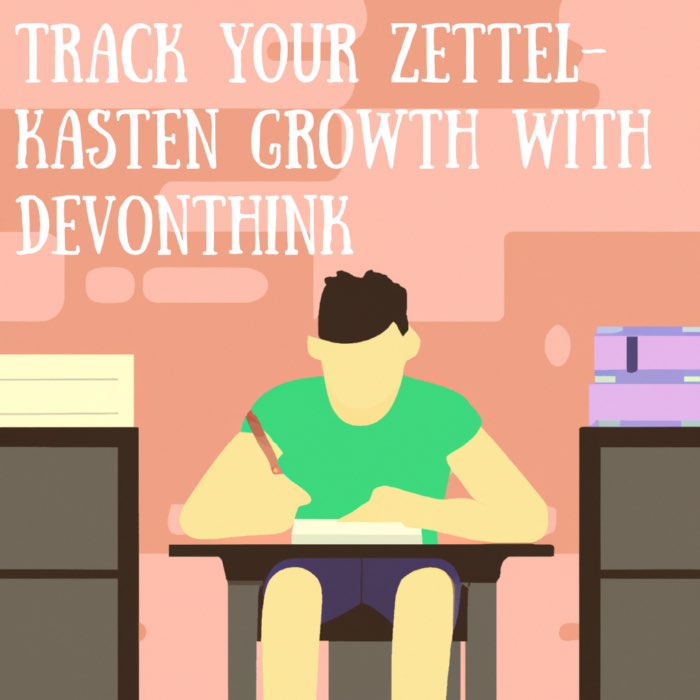
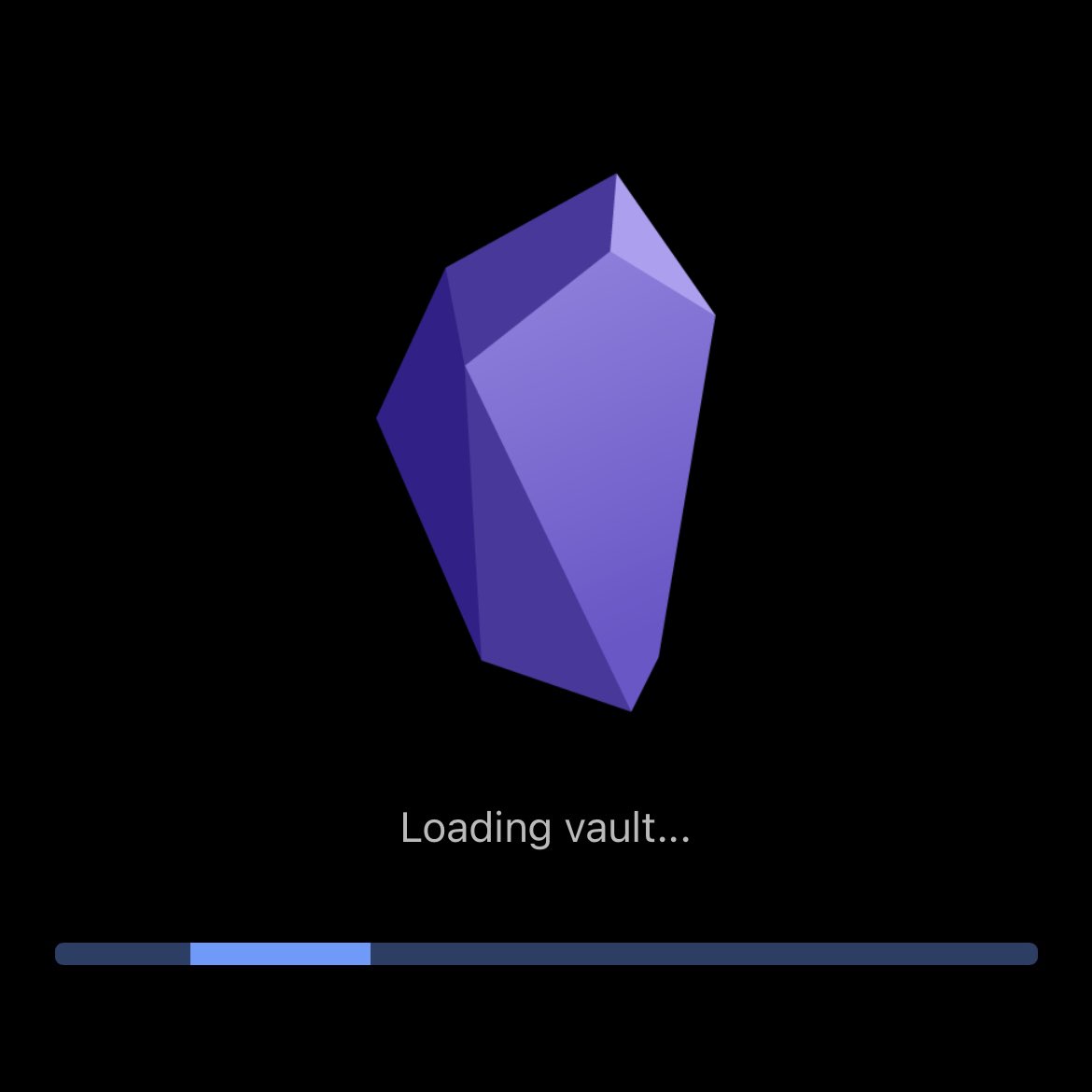
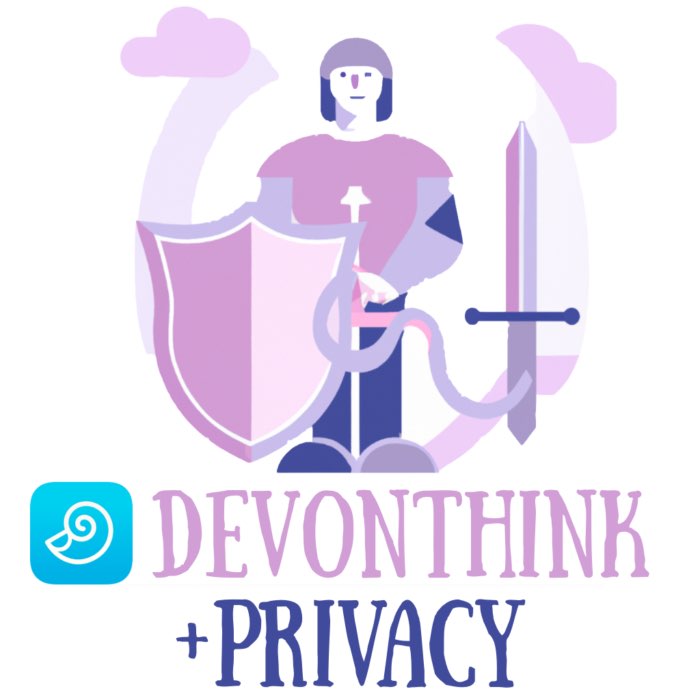
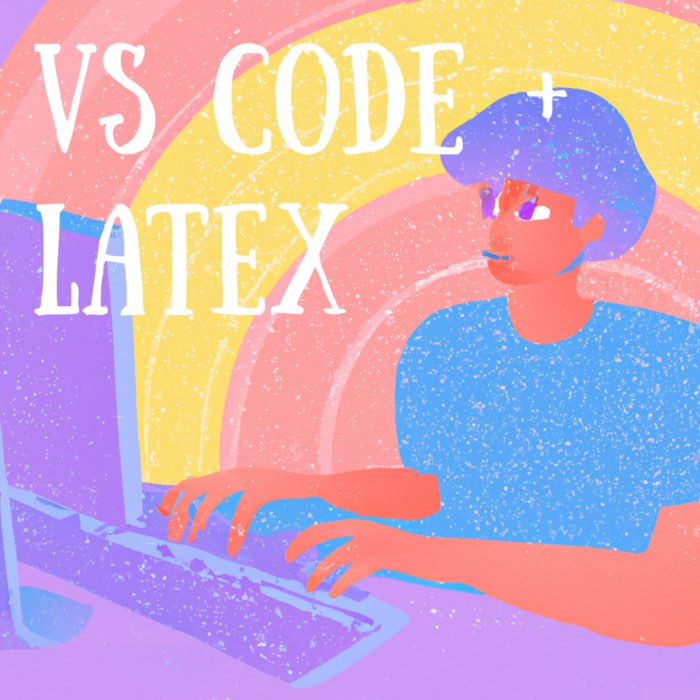
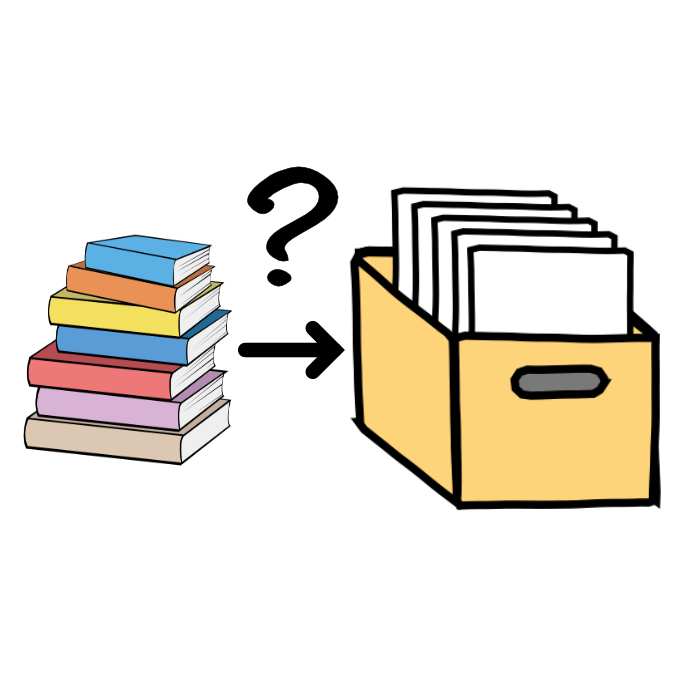
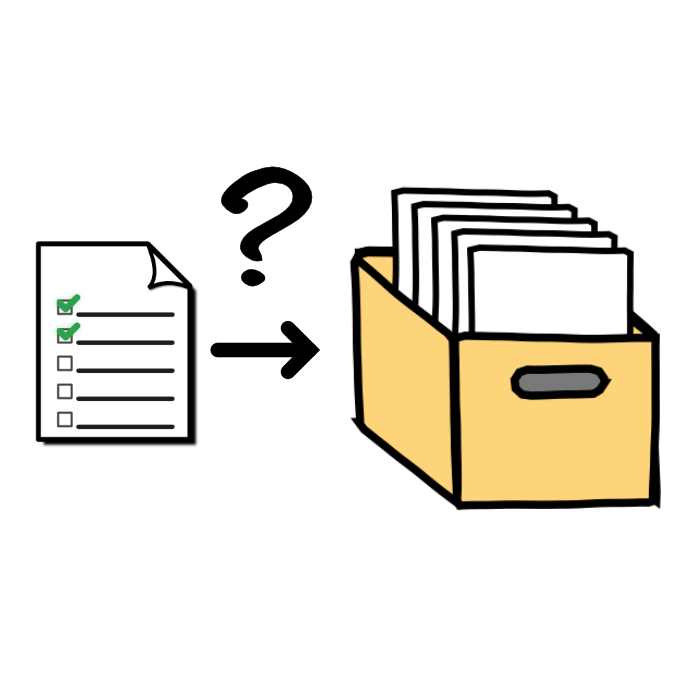
comments